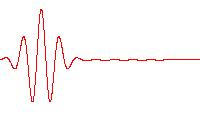User:Johnjbarton/sandbox/complementarity
Complementarity[edit]
Bohr's resolution of these contradictions is to accept them. Wave-particle duality as a physical model derives from Niels Bohr's 1926 presentation in Como, Italy, at a scientific celebration of the work of Alessandro Volta 100 years previous.[1]: 103 Bohr's subject was complementarity, the idea that measurements of quantum events provide complementary information through seemingly contradictory results.[2] In his Como lecture he says: "our interpretation of the experimental material rests essentially upon the classical concepts."[2] Direct observation being impossible, observations of quantum effects are necessarily classical. Whatever the nature of quantum events, our only information will arrive via classical results. If experiments sometimes produce wave results and sometimes particle results, that is the nature of light and of the ultimate constituents of matter. While Bohr's presentation was not well received at that time, it did crystallize the issues ultimately leading to the modern wave-particle duality concept.[3]: 315
Relation to uncertainty principle[edit]
Bohr's concept of complementarity encompasses both wave-particle duality and the uncertainty principle. In modern use, the uncertainty principle focuses on relationships between accuracy of variables, like position versus momentum, while wave-particle duality focuses on the tradeoff of interference fringe visibility with particle path distinguishability.[4] In the extreme case of a known position, the uncertainty principle predicts all possible momentum values are equally likely; conversely, a state with known momentum (a plane wave) is completely delocalized; these extreme cases express wave-particle duality.[5]
Complementarity[edit]
To quote Bohr[3]: 244
When equipment was set up to investigate the interference of light, as in Young's famous two-slits experiment, it was the wave nature of light that was manifest. If it was an experiment to study the photoelectric effect by shining a beam of light on a metal surface, then it was light as a particle that would be observed. To ask whether light is either a wave or a particle is meaningless.
Complementarity and the quantum eraser[edit]
Immediately after Bohr's introduction of complementarity, the concept that include wave-particle duality, Einstein and others sought to define experiments which could detect particle paths in wave-interference experiments.[1]: 115 Over time the proposed experiments centered on interference, like a double-slit experiment, and they gradually became more sophisticated. In the last few decades these conceptual experiments have been realized and published.
The firsts versions proposed methods to determining "which way" a particle traveled. Feynman described one variant in 1965: use light to "look" electrons coming out of the slits in a double slit experiment; according to Bohr's complementarity, the electrons would no longer interfere.[6]: III:1-6 Wheeler proposed " delayed choice" experiments based on rapidly altering one arm of interferometer so that properties viewed as assigned to a particle could not change due the change in the apparatus.[7] To avoid altering the character of a particle through collisions, Marlan Scully and Kai Druhl proposed a new type of experiment they called a "quantum eraser";[1]: 328 they use two sources or two slits with some "marker" like polarization for one of the two to track the particle origin. Whenever the marker is checked, duality predicts that the interference will disappear.
Technological advances have allowed these kinds of experimental concepts to realized.[8] (Analysis of these experiments is closely related to the analysis of quantum entanglement.[9]) These experiments verify wave-particle duality: whenever particle properties are detectable, wave interference vanishes. Classical models for quantum mechanics fail, consistent with the views of Bohr and of Wheeler "no elementary phenomenon is a phenomenon until it is a registered phenomenon".[7]
Wave packet interpretation[edit]
In 1926 Schrödinger introduced his wave equation and in the next paper he proposed that the electron existed in the form of a wave packet, a combination of waves bundled together such that their outline looks particle-like. His analysis turn out to be correct only for the particular (unrealistic) example he used; both Lorentz and Heisenberg immediately pointed out that in all other cases the electron bundle would rapidly spread-out, eliminating any resemblance to a localized particle.[10]: 829 Additional analysis by other physicists concluded that electrons and other subatomic particles cannot be represented by wave packets. Schrödinger's work did contribute to future understanding of "minimum uncertainty" and the development of coherent states important for understanding superconductivity.
- ^ a b c Baggott, J. E. (2013). The quantum story: a history in 40 moments (Impression: 3 ed.). Oxford: Oxford Univ. Press. ISBN 978-0-19-965597-7.
- ^ a b Bohr, N. (1928). "The Quantum Postulate and the Recent Development of Atomic Theory". Nature. 121 (3050): 580–590. Bibcode:1928Natur.121..580B. doi:10.1038/121580a0.
- ^ a b Kumar, Manjit (2011). Quantum: Einstein, Bohr, and the Great Debate about the Nature of Reality (Reprint ed.). W. W. Norton & Company. pp. 242, 375–376. ISBN 978-0-393-33988-8.
- ^ Sen, D. “The Uncertainty Relations in Quantum Mechanics.” Current Science, vol. 107, no. 2, 2014, pp. 203–18. JSTOR, http://www.jstor.org/stable/24103129. Accessed 14 Aug. 2023.
- ^ Scully, Marian O.; Englert, Berthold-Georg; Walther, Herbert (1991-05-01). "Quantum optical tests of complementarity". Nature. 351 (6322): 111–116. doi:10.1038/351111a0. ISSN 0028-0836.
- ^ Feynman, Richard P.; Leighton, Robert B.; Sands, Matthew L.; Feynman, Richard P. (2007). Quantum mechanics. The Feynman lectures on physics / Richard P. Feynman; Robert B. Leighton; Matthew Sands (Nachdr. ed.). Reading/Mass.: Addison-Wesley. ISBN 978-0-201-02118-9.
- ^ a b Ma, Xiao-song; Kofler, Johannes; Zeilinger, Anton (2016-03-03). "Delayed-choice gedanken experiments and their realizations". Reviews of Modern Physics. 88 (1). doi:10.1103/RevModPhys.88.015005. ISSN 0034-6861.
- ^ Aharonov, Yakir; Zubairy, M. Suhail (2005-02-11). "Time and the Quantum: Erasing the Past and Impacting the Future". Science. 307 (5711): 875–879. doi:10.1126/science.1107787. ISSN 0036-8075.
- ^ Zeilinger, Anton (1999-03-01). "Experiment and the foundations of quantum physics". Reviews of Modern Physics. 71 (2): S288–S297. doi:10.1103/RevModPhys.71.S288. ISSN 0034-6861.
- ^ Kragh, Helge (2009), Greenberger, Daniel; Hentschel, Klaus; Weinert, Friedel (eds.), "Wave Packet", Compendium of Quantum Physics, Berlin, Heidelberg: Springer Berlin Heidelberg, pp. 828–830, doi:10.1007/978-3-540-70626-7_232, ISBN 978-3-540-70622-9, retrieved 2023-08-13


